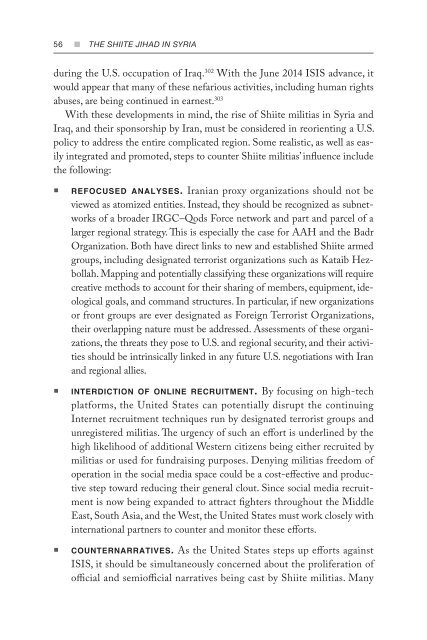You also want an ePaper? Increase the reach of your titles
YUMPU automatically turns print PDFs into web optimized ePapers that Google loves.
56 n <strong>THE</strong> <strong>SHIITE</strong> <strong>JIHAD</strong> <strong>IN</strong> <strong>SYRIA</strong><br />
during the U.S. occupation of Iraq. 302 With the June 2014 ISIS advance, it<br />
would appear that many of these nefarious activities, including human rights<br />
abuses, are being continued in earnest. 303<br />
With these developments in mind, the rise of Shiite militias in Syria and<br />
Iraq, and their sponsorship by Iran, must be considered in reorienting a U.S.<br />
policy to address the entire complicated region. Some realistic, as well as easily<br />
integrated and promoted, steps to counter Shiite militias’ influence include<br />
the following:<br />
• refocused analyses. Iranian proxy organizations should not be<br />
viewed as atomized entities. Instead, they should be recognized as subnetworks<br />
of a broader IRGC–Qods Force network and part and parcel of a<br />
larger regional strategy. This is especially the case for AAH and the Badr<br />
Organization. Both have direct links to new and established Shiite armed<br />
groups, including designated terrorist organizations such as Kataib Hezbollah.<br />
Mapping and potentially classifying these organizations will require<br />
creative methods to account for their sharing of members, equipment, ideological<br />
goals, and command structures. In particular, if new organizations<br />
or front groups are ever designated as Foreign Terrorist Organizations,<br />
their overlapping nature must be addressed. Assessments of these organizations,<br />
the threats they pose to U.S. and regional security, and their activities<br />
should be intrinsically linked in any future U.S. negotiations with Iran<br />
and regional allies.<br />
• interdiction of online recruitment. By focusing on high-tech<br />
platforms, the United States can potentially disrupt the continuing<br />
Internet recruitment techniques run by designated terrorist groups and<br />
unregistered militias. The urgency of such an effort is underlined by the<br />
high likelihood of additional Western citizens being either recruited by<br />
militias or used for fundraising purposes. Denying militias freedom of<br />
operation in the social media space could be a cost-effective and productive<br />
step toward reducing their general clout. Since social media recruitment<br />
is now being expanded to attract fighters throughout the Middle<br />
East, South Asia, and the West, the United States must work closely with<br />
international partners to counter and monitor these efforts.<br />
• counternarratives. As the United States steps up efforts against<br />
ISIS, it should be simultaneously concerned about the proliferation of<br />
official and semiofficial narratives being cast by Shiite militias. Many


